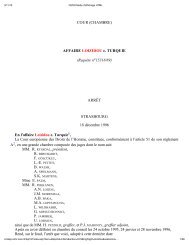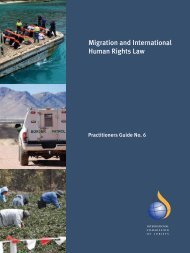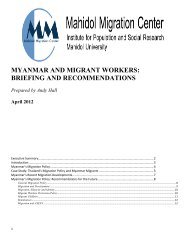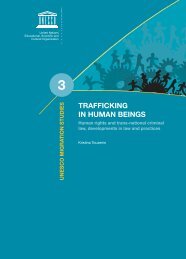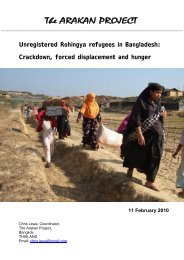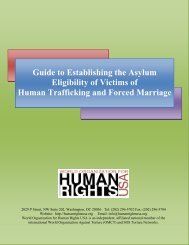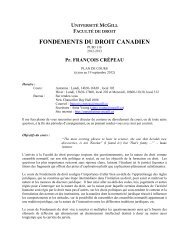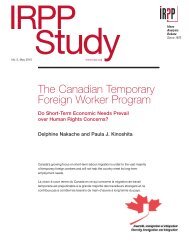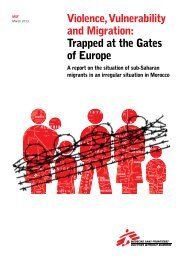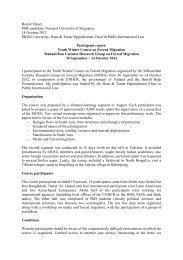EU Membership Highlights Poland's Migration Challenges
EU Membership Highlights Poland's Migration Challenges
EU Membership Highlights Poland's Migration Challenges
Create successful ePaper yourself
Turn your PDF publications into a flip-book with our unique Google optimized e-Paper software.
Figure 5. Estimated Size of Polish National Population in the United Kingdom by Quarter, 2004 to<br />
2010<br />
There is some consistency between Polish and British surveys of Polish migrant workers about the intent of return. Generally, Poles are less certain about<br />
their future plans and do not want to make radical decisions; they are trying to find out where they have better opportunities. In this recent recession,<br />
decent conditions in Poland, despite high unemployment rates there, could have proven better than unemployment abroad for some individuals.<br />
Making Immigration Policy after 1989<br />
After communism collapsed, the Polish government realized it had extremely limited experience with immigration and lacked the legal foundations and<br />
policies to deal with people intent on entering the country. The government also lacked money to fund the structures necessary for handling asylum and<br />
migration-related procedures and paperwork.<br />
Along with other Central European countries, Poland witnessed several new trends in a short period of time. These included<br />
the massive short-term mobility of citizens from the former Soviet Union;<br />
labor migration to both Eastern and Western Europe;<br />
permanent migration into Poland, mainly from other Eastern European countries;<br />
the formation of new immigrant communities of Chinese, Vietnamese, and Armenian origin;<br />
inflows of asylum seekers;<br />
lower levels of emigration;<br />
the return of Polish citizens living abroad<br />
Several experts concurrently pointed to various public security threats and called for a coordinated state response. These opinions, prevalent among the<br />
public and with policy experts, sent a clear message to <strong>Poland's</strong> politicians that a "law and order" approach to policymaking was expected.<br />
In 1989, the only law dealing with migration was the Aliens Act of 1963, which was enacted when few foreigners entered Poland. The act defined the<br />
conditions of entry into the country, internal movement, and departure.<br />
Although work on a new Aliens Act began in 1992, it took five years to complete an updated version. Ultimately, the Aliens Act of 1997 enabled the free<br />
movement of persons and focused mostly on the conditions for entry, stay, and transit through Poland. It was also mindful, however, of national security,<br />
potential <strong>EU</strong> accession, and human rights issues.<br />
In April 2001, the Polish Parliament passed comprehensive amendments to the Aliens Act to help clear the path toward <strong>EU</strong> membership. One of the<br />
significant changes included establishing the Office for Repatriation and Foreigners. This became the first separate government agency dealing solely with<br />
migration issues.<br />
A separate Repatriation Act, which came into force in January 2001, was the first comprehensive document regulating resettlement of people of "Polish<br />
ethnicity or descent," including people living in the Asian part of the former Soviet Union. This law made it easier for those who, "due to deportations,<br />
exile and other ethnically motivated forms of persecution could not settle in Poland."<br />
The Repatriation Act also clarified the means for acquiring Polish citizenship and outlined types of resettlement assistance. It applies to those who have<br />
maintained cultural ties to Poland and have at least one parent, grandparent, or two great-grandparents who are of Polish ancestry.<br />
What proved more difficult was <strong>Poland's</strong> obligation to implement Schengen requirements, which meant mandating visas from nationals of its eastern<br />
neighbors, Ukraine and Belarus, as well as Russia.<br />
Many worried that such visa requirements could weaken cross-border trade, cause the market for exports to the former Soviet Union to collapse, and<br />
decrease the income of people dependent on trade-related services.<br />
Consequently, the Polish government waited until October 2003 to make these visas mandatory. Although cross-border mobility initially decreased,<br />
numbers returned to pre-visa levels by March 2005 thanks to efforts by Polish consulates and improvements in the visa regime's administration.<br />
Also in 2003, Poland implemented two laws, the Act of Protection of Aliens and the 2003 Aliens Act, which further refined the 2001 changes.<br />
The Act of Protection of Aliens clearly divides asylum from economic migration issues. It includes principles and conditions for extending various forms of<br />
protection to foreigners, including refugee status, asylum status, temporary protection status, and tolerated status. Tolerated status was created to cover<br />
mainly Chechens whose asylum claims have been rejected but who cannot be sent home.<br />
The 2003 Aliens Act included <strong>Poland's</strong> first regularization program for unauthorized immigrants. The Office of Repatriation and Foreigners estimated the<br />
total unauthorized population at that time at around 45,000 to 50,000.<br />
However, the regularization, which was in force from September 1 to December 31, 2003, largely failed. Only those who had lived continuously in Poland<br />
for five years were eligible. In addition, no formal information about the program was written, and the information that was provided did not reach the<br />
majority of illegal immigrants. By the end of the program, 2,747 out of 3,512 applications (78 percent) had been approved, with 1,245 Armenians and<br />
1,078 Vietnamese receiving legal status.<br />
Making Policy after 2004: New Policy Concerns<br />
Since mid-2005, policymakers have discussed immigration in terms of social or economic policy, focusing on the following:<br />
return migration of Poles who emigrated to Western Europe



